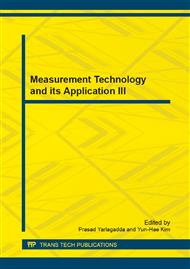[1]
G. A. Cranch, Large-scale remotely interrogated arrays of fiber-optic interferometric sensors for underwater acoustic applications, IEEE Sensors Journal 3 (2003) 19-30.
DOI: 10.1109/jsen.2003.810102
Google Scholar
[2]
N. Albor, J. Herr, S. Mastrogiovanni et al., Comparison of fiber optic and conventional sensors for naval applications, Naval Engineers Journal 108 (1996) 29-42.
DOI: 10.1111/j.1559-3584.1996.tb00502.x
Google Scholar
[3]
M. Pang, and W. Jin, Detection of acoustic pressure with hollow-core photonic bandgap fiber , Optics Express 17 (2009) 11088-11097.
DOI: 10.1364/oe.17.011088
Google Scholar
[4]
Y. Leguillona et al., Phase sensitivity to axial strain of microstrustured optical silica fibers, 21st International Conference on Optical Fiber Sensors (2011).
DOI: 10.1117/12.884793
Google Scholar
[5]
H. K. Kim, M. J. F. Digonnet, and G. S. Kino, Air-core photonic-bandgap fiber-optic gyroscope , Journal of Light Wave Technology 24 (2006) 3169-3174.
DOI: 10.1109/jlt.2006.880689
Google Scholar
[6]
Information on NKT Photonics website, http: /www. nktphotonics. com/hollowcorefibers.
Google Scholar
[7]
W. Jin, H. F. Xuan, and H. L. Ho, Sensing with hollow-core photonic bandgap fibers, Measurement Science and Technology 21 (2010) 1-12.
DOI: 10.1088/0957-0233/21/9/094014
Google Scholar
[8]
F. B. Jensen, W. A. Kuperman, M. B. Porter et al., Computational Ocean Acoustics, Springer, New York, (2011).
Google Scholar
[9]
S. R. Thompson, Sound Propagation Consideration for a Deep-ocean Acoustic Network, Naval Postgraduate School, (2009).
Google Scholar
[10]
H. David, and P. Nash, Fibre-optic hydrophone array for acoustic surveillance in the littoral, Proc. SPIE 5780 (2005) 1-10.
Google Scholar
[11]
O. Kilic, M. Digonnet, G. Kino et al., Photonic-crystal-diaphragm-based fiber-tip hydrophone optimized for ocean acoustics, Proc. SPIE 7004 (2008) 700405-1- 700405-4.
DOI: 10.1117/12.785919
Google Scholar
[12]
F. C. DeMetz, Sensitivity requirements for fiber optic pressure and velocity sensors, Proc. SPIE 5278 (2003) 32-41.
DOI: 10.1117/12.544378
Google Scholar
[13]
R. P. Hodges, Underwater Acoustics: Analysis, Design and Performance of Sonar, John Wiley & Sons, (2011).
Google Scholar
[14]
R. E. Francois, and G. R. Garrison, Sound absorption based on ocean measurements. Part II: Boric acid contribution and equation for total absorption, Journal of Acoustical Society of America 72 (1982) 1879-1890.
DOI: 10.1121/1.388673
Google Scholar
[15]
K. V. Mackenzie, Nine-term equation for sound speed in the oceans, Acoustical Society of America 70(1981) 807-812.
DOI: 10.1121/1.386920
Google Scholar
[16]
G. M. Wenz, Acoustic ambient noise in the ocean: spectra and sources, Journal of Acoustical Society of America 34(1962) 1936-(1956).
DOI: 10.1121/1.1909155
Google Scholar
[17]
S. M. Hariharan, S. Kamal, and S. P. R. Pillai, Reduction of self-noise effects in onboard acoustic receivers of vessels using spectral subtraction, Proceedings of the Acoustics 2012 (2012) 3793-3798.
Google Scholar
[18]
C. K. Kirkendall, and A. Dandridge, Overview of high performance fiber-optic sensing, Journal of Physics D 37(2004) R197- R216.
DOI: 10.1088/0022-3727/37/18/r01
Google Scholar
[19]
C. M. Payne, Principles of Naval Weapon Systems, Naval Institute Press, (2010).
Google Scholar


